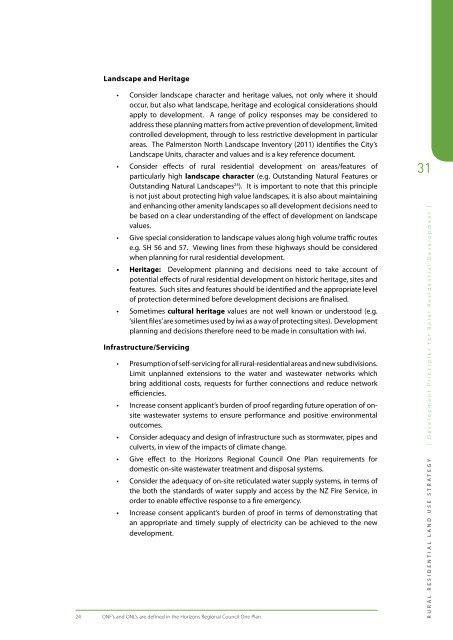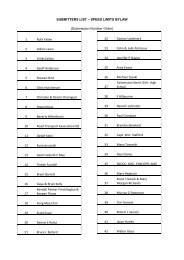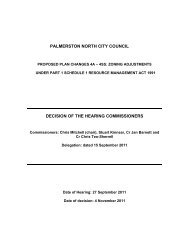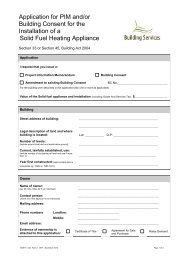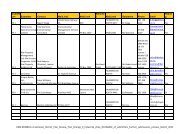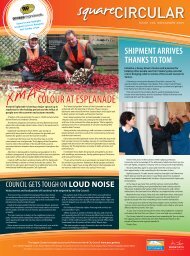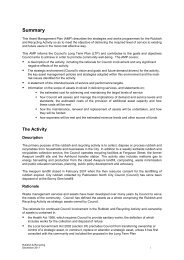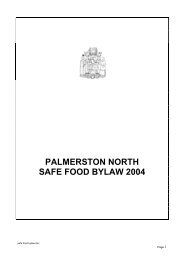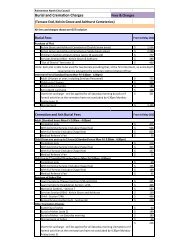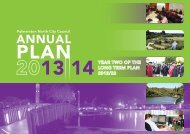Rural Residential Land Use Strategy - Palmerston North City Council
Rural Residential Land Use Strategy - Palmerston North City Council
Rural Residential Land Use Strategy - Palmerston North City Council
Create successful ePaper yourself
Turn your PDF publications into a flip-book with our unique Google optimized e-Paper software.
<strong>Land</strong>scape and Heritage<br />
• Consider landscape character and heritage values, not only where it should<br />
occur, but also what landscape, heritage and ecological considerations should<br />
apply to development. A range of policy responses may be considered to<br />
address these planning matters from active prevention of development, limited<br />
controlled development, through to less restrictive development in particular<br />
areas. The <strong>Palmerston</strong> <strong>North</strong> <strong>Land</strong>scape Inventory (2011) identifies the <strong>City</strong>’s<br />
<strong>Land</strong>scape Units, character and values and is a key reference document.<br />
• Consider effects of rural residential development on areas/features of<br />
particularly high landscape character (e.g. Outstanding Natural Features or<br />
Outstanding Natural <strong>Land</strong>scapes 24 ). It is important to note that this principle<br />
is not just about protecting high value landscapes, it is also about maintaining<br />
and enhancing other amenity landscapes so all development decisions need to<br />
be based on a clear understanding of the effect of development on landscape<br />
values.<br />
• Give special consideration to landscape values along high volume traffic routes<br />
e.g. SH 56 and 57. Viewing lines from these highways should be considered<br />
when planning for rural residential development.<br />
• Heritage: Development planning and decisions need to take account of<br />
potential effects of rural residential development on historic heritage, sites and<br />
features. Such sites and features should be identified and the appropriate level<br />
of protection determined before development decisions are finalised.<br />
• Sometimes cultural heritage values are not well known or understood (e.g.<br />
‘silent files’ are sometimes used by iwi as a way of protecting sites). Development<br />
planning and decisions therefore need to be made in consultation with iwi.<br />
Infrastructure/Servicing<br />
• Presumption of self-servicing for all rural-residential areas and new subdivisions.<br />
Limit unplanned extensions to the water and wastewater networks which<br />
bring additional costs, requests for further connections and reduce network<br />
efficiencies.<br />
• Increase consent applicant’s burden of proof regarding future operation of onsite<br />
wastewater systems to ensure performance and positive environmental<br />
outcomes.<br />
• Consider adequacy and design of infrastructure such as stormwater, pipes and<br />
culverts, in view of the impacts of climate change.<br />
• Give effect to the Horizons Regional <strong>Council</strong> One Plan requirements for<br />
domestic on-site wastewater treatment and disposal systems.<br />
• Consider the adequacy of on-site reticulated water supply systems, in terms of<br />
the both the standards of water supply and access by the NZ Fire Service, in<br />
order to enable effective response to a fire emergency.<br />
• Increase consent applicant’s burden of proof in terms of demonstrating that<br />
an appropriate and timely supply of electricity can be achieved to the new<br />
development.<br />
24 ONF’s and ONL’s are defined in the Horizons Regional <strong>Council</strong> One Plan.<br />
31<br />
RURAL RESIDENTIAL LAND USE STRATEGY [ Development Principles for <strong>Rural</strong> <strong>Residential</strong> Development ]


